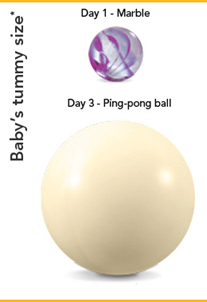|
FIRST TRIMESTER: In the first few weeks of pregnancy, the embryo develops three layers of cells. · The Endoderm: it will eventually become your baby's digestive system. · The Mesoderm: it is the source of the sex organs, bones, kidneys and muscles. · The Ectoderm, or outer layer, develops into the nervous system, hair, skin and eyes. At its most basic level, the digestive system is a series of tubes leading from the mouth to the anus. By about 8 weeks’ gestation, that tube is starting to form along with the stomach. By about week 10, the stomach starts to produce digestive juices and enzymes. For now, your baby is getting all his nutrition from you, via the placenta and umbilical cord (and he’s sending the waste right back into the placenta). Her own digestive system won’t take over for real until she is born and starts consuming breast milk or formula. SECOND TRIMESTER: Early in the second trimester, around week 13, the digestive system’s structures are fully formed and in the right places. Now it’s time for practice: Baby begins to suck and swallow amniotic fluid and the muscles and organs that make up the digestive system start to contract. He also pees every 40 minutes. These are all tasks that baby will rely on for digestion once she’s out in the world, consuming breast milk, formula and eventually solid food. THIRD TRIMESTER: The digestive system continues to practice its waste management duties, but it won’t be fully ready for prime time until your baby is born and starts taking all her nutrition by mouth (instead of by umbilical cord). Still, in the final weeks of pregnancy, the digestive system gets ready for its own first delivery: meconium starts to build up in the intestine. This is baby’s first bowel movement. Instead of food, it’s made up of the stuff your baby collected in his intestines while in utero (like old blood cells and skin cells), which is why it looks so drastically different from the baby poop yet to come.  FIRST WEEKS AFTER BIRTH During gestation, your baby received nutrients and disposed of waste products through the placenta. At birth, this changed abruptly, but your newborn's digestive system is still very immature. As a result, he may lose up to 10 percent of his body weight in the first days of his life, as he adjusts to using his digestive system. Because a newborn's stomach is small, your infant needs frequent feedings. Breast milk is high in fat because that's the most efficient way for your baby to meet his caloric needs. Ounce for ounce, fat contains over twice as many calories as proteins or carbohydrates. Your baby’s tummy is about the size of a small marble at birth. After three days, it is about the size of a ping-pong ball, but still can’t hold much.1 Until she is about 4 months old, your baby’s tummy can hold only small amounts of milk at a time. Too much milk during feedings can cause your baby to spit up or be fussy. Spitting up can happen when your baby: · Burps (this is called a wet burp) · Eats too much · Swallows too much air There is no reason to worry about these common causes for your baby spitting up. It is not painful, and most babies do not even realize they have done it. As long as your baby is healthy and gaining weight, it is simply part of the development process. It might seem like a lot, but the amount of liquid your baby spits up might not be as much as you think. One tablespoon is normal, but it looks like a lot. WHAT IS COLIC? The cause of colic is unknown. Researchers have explored a number of possibilities, including allergies, lactose intolerance, changes in the normal bacteria found in the digestive system, a digestive system that hasn't fully developed, anxious parents, and differences in the way a baby is fed or comforted. Yet it's still unclear why some babies have colic and others don't. The "Rule Of Threes." When infants cry for three or more hours a day at least three days a week for three weeks or more, it could be colic. Colic generally begins at 2 to 3 weeks; it is unusual after 3 months. Fussing and crying are normal for infants, and a fussy baby doesn't necessarily have colic. In an otherwise healthy, well-fed baby, signs of colic include: · Predictable crying episodes. · Intense or inconsolable crying. · Crying that occurs for no apparent reason. · Posture changes. Curled up legs, clenched fists and tensed abdominal muscles. · It usually starts a few weeks after birth and often improves by age 3 months. By ages 4 to 5 months, the majority of babies with colic have improved. THE HOMOEOPATHIC APPROACH If we understand the stages through which a new born baby’s digestive system develops, then it is easier to stay calm when baby has reflux, gas, diarrhea and some discomfort. Crying is your baby’s only way of telling you something is bothering him. It does not always mean he is experiencing serious discomfort. Check first to see if he is too cool or warm, hungry, gassy, or tired, or if he needs a diaper change. Colic improves on its own, often by age 3 months. Unfortunately, there are no proven treatments that consistently help every baby. Treatments that have been tried include: · Gas & Cramp -relief medications: · Calming the tummy nerves · Probiotics. Probiotics are substances that help maintain the natural balance of "good" bacteria in the digestive tract. This kind of treatment is relative expensive so do not experiment without seeking advice from a knowledgeable practitioner.  Homoeopathic remedies that can be considered: · Carbo vegetabilis is indicated for flatulence, and burning crampy, stomach pain. · Magnesium Phosphoricum is used to treat abdominal bloating and flatulent colic. · Strychnos nux-vomica is indicated for flatulence, symptoms that are associated with mental strain and rritability. All the above remedies are found in Natura Magen.  · Achillea millefolium relieves acute pain in the pit of the stomach. · Arnica montana relieves stomach pain and abdominal discomfort associated with loose stools and aversion to touch. · Calendula officinalis quietens apparent hunger in a baby who has just nursed. · Centaurium erythraea helps relieve gripping abdominal pains and colic with excessive flatulence and which tends to be more severe at night. · Matricaria recutita (Chamomilla) is indicated for painful teething, regurgitation of food, abdominal distension and colic accompanied by loose stools. All the above remedies are found in Natura Cesranol 
All the above remedies are found in Natura Sedaped Good advice A good support system gives you a much needed break when your baby’s crying becomes overwhelming. Ask for help from your partner or a family member to get relief or sleep when you need it. If the crying makes you feel like you might lose control, calmly and safely place your baby in a crib, and step away briefly to collect your thoughts and calm down. Feeling overwhelmed is only temporary — never shake an infant. Resources: All content here, including advice from doctors and other health professionals, should be considered as opinion only. Always seek the direct advice of your own practitioner in connection with any questions or issues you may have regarding your own health or the health of others. www.livestrong.com › Diseases and Conditions 1. Spangler AK, et al. J Hum Lact. 2008;24:199-205. 2. Behrman RE, et al. Nelson Textbook of Pediatrics. 16th ed. Philadelphia: WB Saunders Co., 2000:165. 3. Samour PQ and King K. Handbook of Pediatric Nutrition. 3rd ed. Sudbury, MA: Jones and Bartlett Publishers, 2005:90. 4. Fomon SJ. Infant Nutrition. 2nd ed. Philadelphia: WB Saunders Co., 1974:24. Mayo Clinic Staff Natura Website - http://www.comedhealth.co.za/
0 Comments
Leave a Reply. |
AuthorsDr. Marike de Klerk Categories
All
|
All rights reserved Naturopathic Health Care Centre
ADDRESS: No 13 Hazelwood Road, Hazelwood, Pretoria
TELEPHONE: 012 460 9216
PAIA Manua
Website design and digital marketing by Plan Me Pretty (PTY) Ltd
TELEPHONE: 012 460 9216
PAIA Manua
Website design and digital marketing by Plan Me Pretty (PTY) Ltd

 RSS Feed
RSS Feed